Nature-related Financial Disclosure Actions
Chunghwa Telecom follows the framework established by the Taskforce on Nature-related Financial Disclosures (TNFD)1 , which was officially released during Climate Week NYC in September 2023. Adhering to the four pillars of governance, strategy, risk and impact management, and metrics and targets, we conduct comprehensive nature-related financial disclosures. By adopting the LEAP2 assessment methodology recommended by TNFD and taking into account the local natural conditions of Taiwan and the availability of relevant data, we have developed a localized Locate and Evaluate analysis process3 to ensure that the entire analysis is more aligned with the local current situation. This allows us to systematically analyze our dependencies on and impacts on nature.
Scope of Chunghwa Telecom's Biodiversity Assessment4
Chunghwa Telecom's operations and value chain include upstream suppliers, our own operational activities, and downstream consumers. Chunghwa Telecom's types of operational sites include base stations, data center facilities, pipeline facilities, submarine cables, satellite stations, business halls and office buildings. We provide a full spectrum of diverse communication services tailored to our customers' needs.
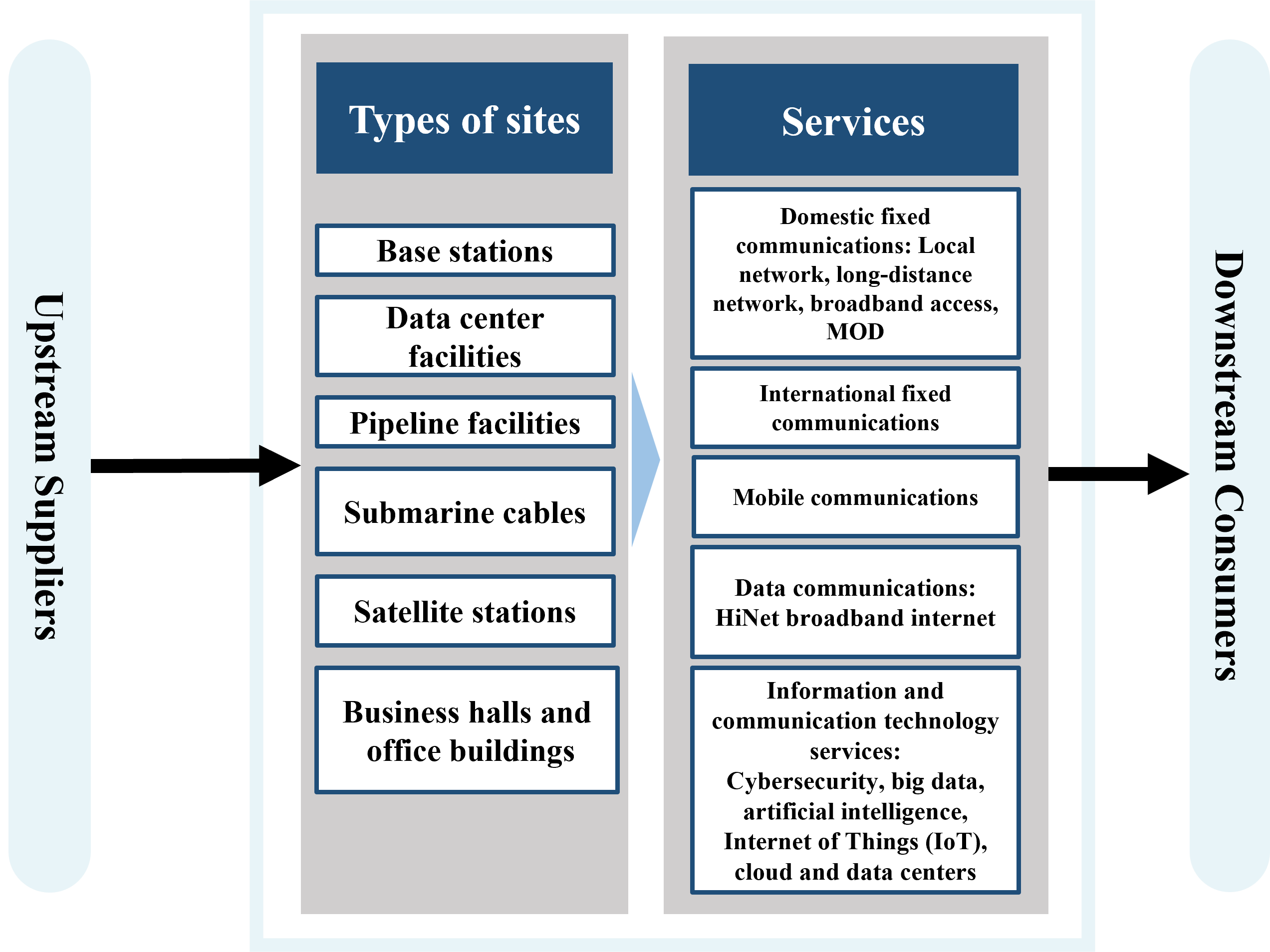
CHT Operational Scope and Value Chain
Biodiversity Risk Analysis Methodology
The taskforce5 referenced the ENCORE6 (Exploring Natural Capital Opportunities, Risks, and Exposure), jointly developed by the United Nations Environment Programme World Conservation Monitoring Centre (UNEP-WCMC) and the Natural Capital Finance Alliance (NCFA) and considered Taiwan's natural conditions and the characteristics of Chunghwa Telecom's operational site types to evaluate the dependencies and impacts of each type of operational site on nature.
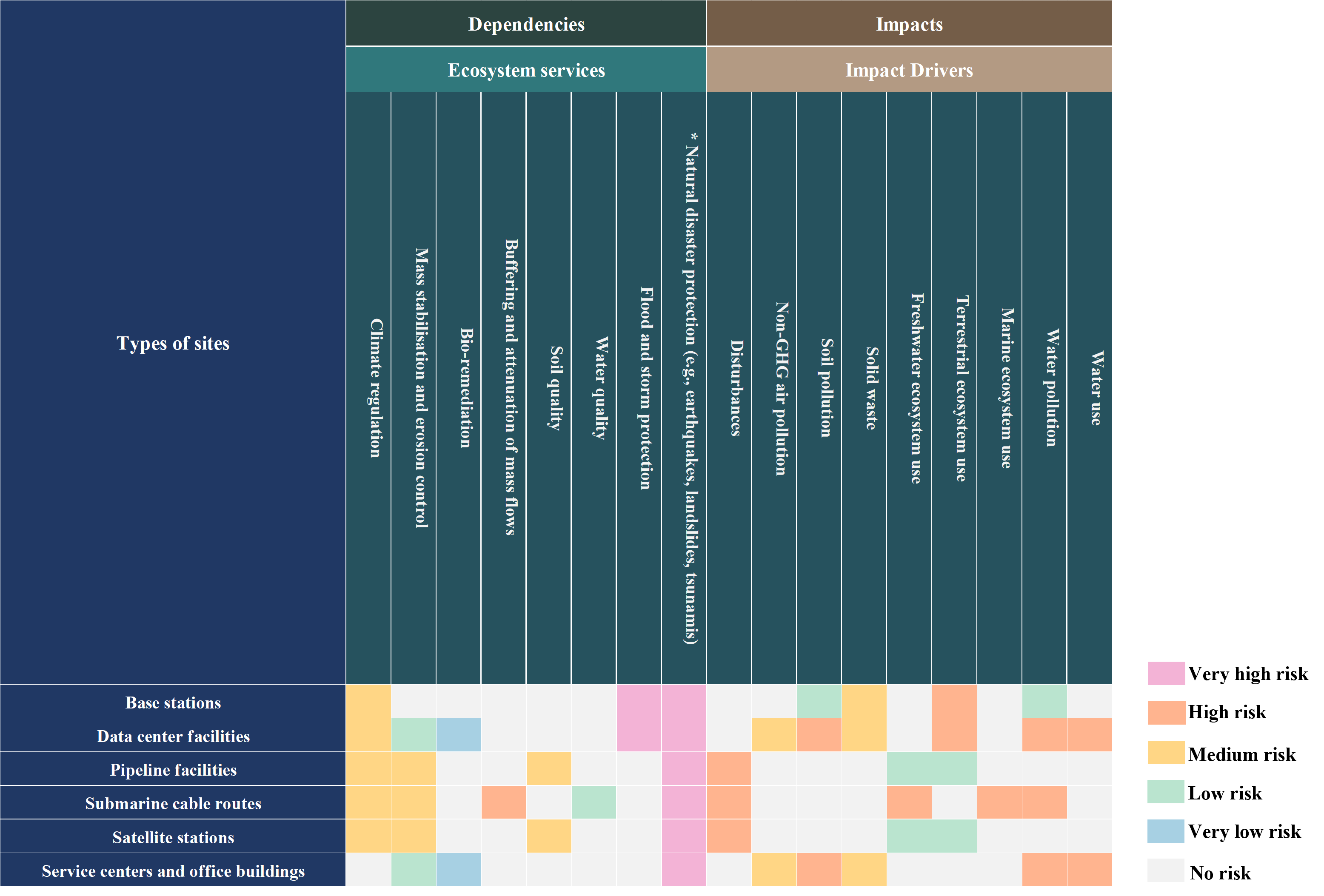
Dependencies and Impacts of Each Chunghwa Telecom's Operational Site Type on Nature
* Note: Indicates additional dependencies specific to Taiwan's local natural conditions and the characteristics of Chunghwa Telecom's operation sites.
➤ Locate:Identifying Nature-sensitive Operational Sites
Due to the widespread distribution of approximately 26,000 base stations across the entire region7, some of which are situated in ecologically protected areas, we referred to the Ministry of the Environment's guidelines on environmental sensitivity to preliminarily screen about 2,500 base stations located in or near biodiversity-sensitive areas8.After the second phase of analysis, the results indicate that the base stations belonging to the first priority assessment category account for only 1% of all base stations in Taiwan.
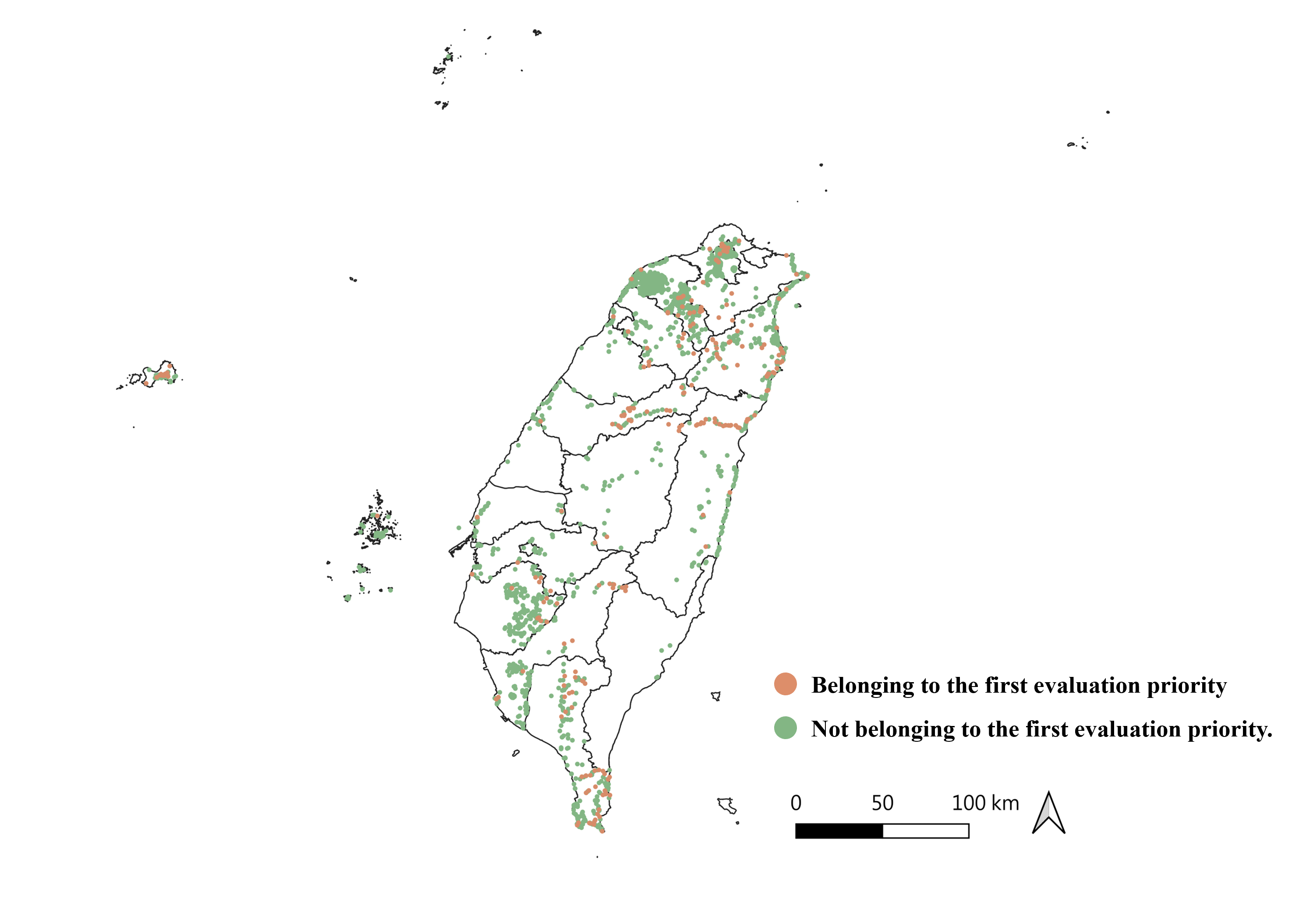
Prioritized evaluation results for the classification of base station locations
➤ Evaluate : Analysis of Dependencies on and Impacts of Nature
Chunghwa Telecom identifies dependencies on and impacts of the nature for base stations by using the localized Evaluate analysis process developed based on the LEAP methodology of the TNFD and Taiwan's current situation.
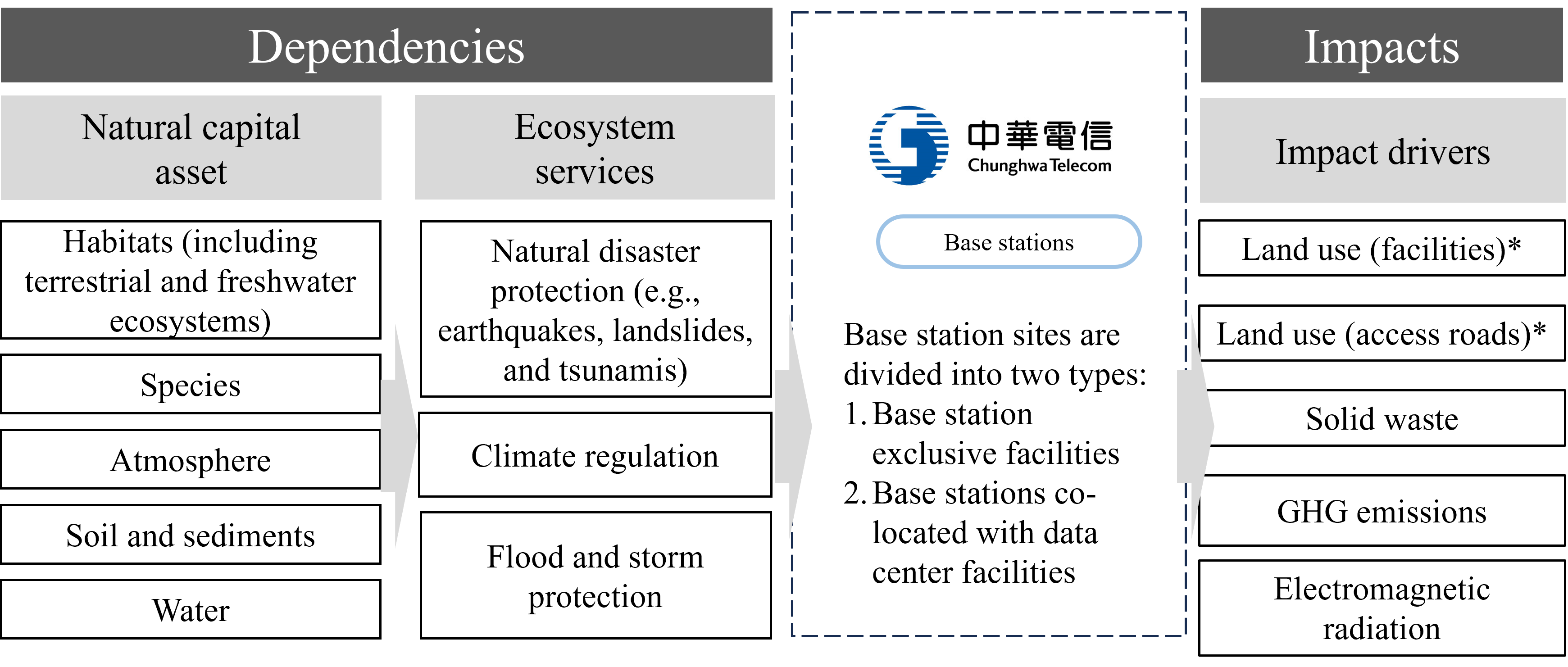
The Relationship Between Chunghwa Telecom Base Stations and Natural Resources, Ecological Advantages, and Contributing Factors
* Note:The construction and maintenance processes may affect the local ecosystem (e.g. vegetation)
In accordance with the ecosystem services and natural capital associated with base stations, we identified the essential dependencies required for their normal operation, which include site stability, electricity, oil, and water resources. Regarding impacts, the operational factors9 affecting these sites encompass land use (facilities), land use (access roads), solid waste , greenhouse gas emissions, and electromagnetic radiation.
Base station dependencies and influencing factors
By synthesizing internal data from Chunghwa Telecom alongside publicly available external information, we established a set of metrics for the assessment of dependencies and impacts.
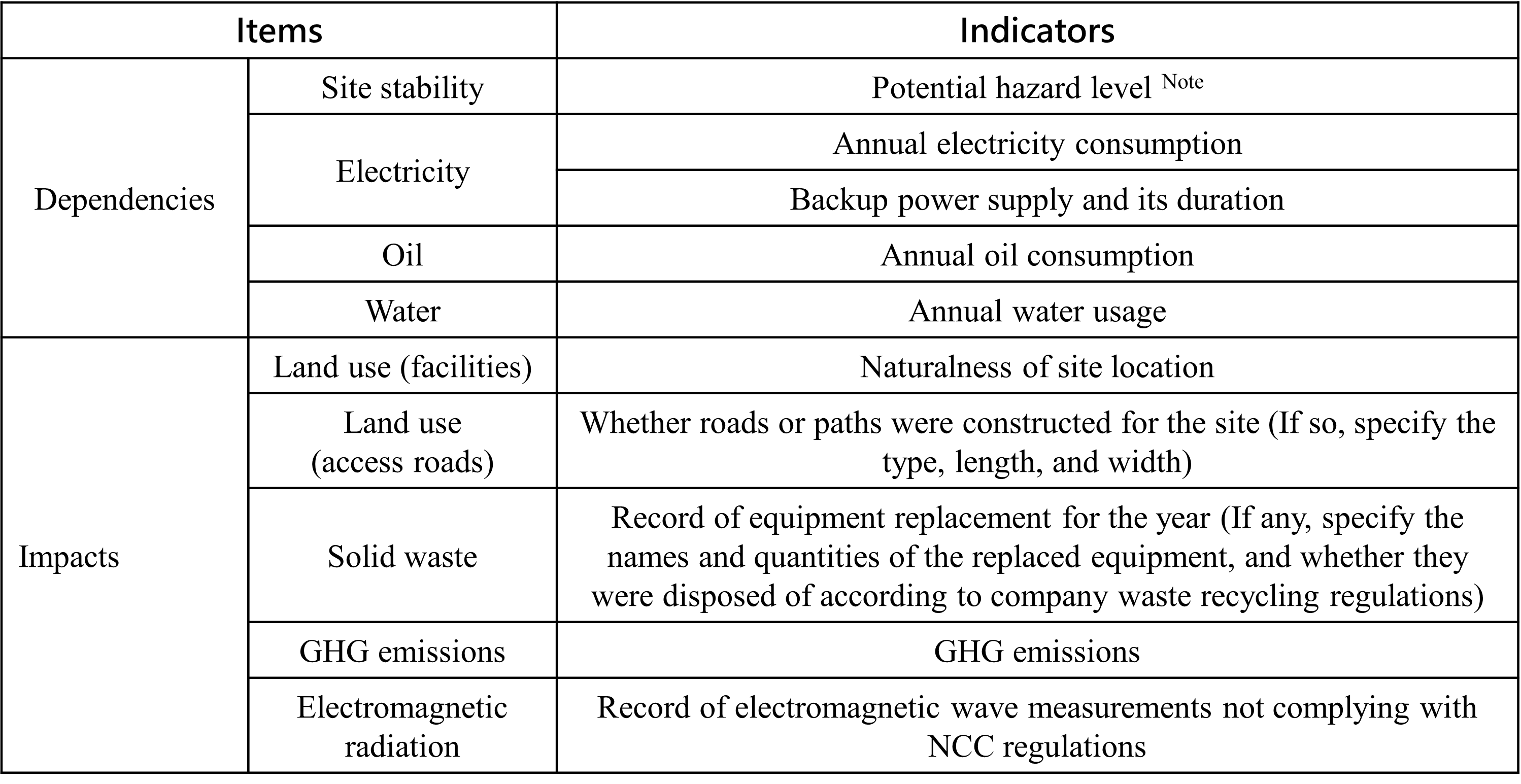
Dependencies and influencing measurement indicators
* Note:The assessment of the potential hazard level is based on whether the site is located directly within or near a 500-meter radius of areas with flooding potential, potential debris flow torrent, large-scale landslide potential areas, dip slopes, rockslide, rockfall, soil liquefaction potential zones, active faults, tsunami inundation potential areas, or volcanic hazard areas.
The process of demonstration site analysis
To establish an applicable evaluation process for base stations, Chunghwa Telecom selected two base stations Taoyuan City, Fuxing District near the Shimen Reservoir Water Quality Protection Area and Chatianshan Nature Reserve — "Fuxing Central Office Base Station" and "Fuxing Chatianshan Base Station" — as demonstration sites for the Evaluate analysis.
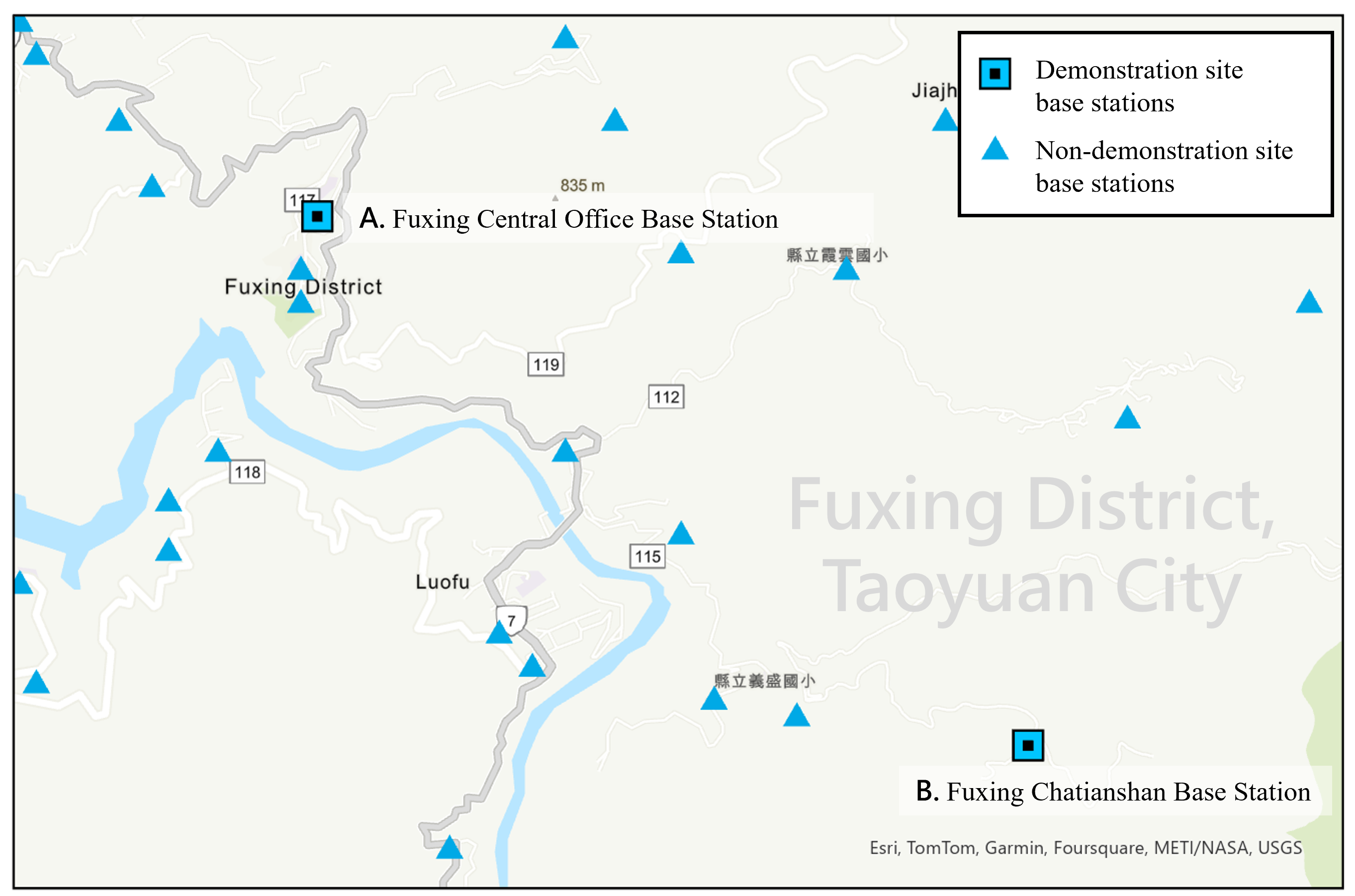
Demonstration Site Location Map
By utilizing indicator measurements, we assess the natural dependencies and impacts of the demonstration site. Based on the criteria for identifying key concerns, we determine that the significant impacts of the demonstration site include greenhouse gas emissions, land use (facilities), and land use (access roads).
| Demonstration Sites for Evaluate Analysis | Fuxing Central Office Base Station | Fuxing Chatienshan Base Station |
| Key material Impacts | Land use (facilities,access roads) | GHG emissions |
| GHG emissions |
➤ Assess : Scenario Analysis for Evaluating Nature Risks and Opportunities
Considering that shortages in dependency items may lead to service interruptions, thereby posing material risks to operations; similarly, impact items that weaken the supply of ecosystem services will also generate material risks and diminish the company's resilience to transformation risks. Proactively implementing risk management strategies can help create opportunities.
During the Assess phase, based on the dependencies and impact items identified in the Evaluate phase, we explore the potential natural risks and opportunities facing operations to achieve sustainable development. The working group references the TNFD scenario analysis guidelines and consolidates the identification of natural risks and opportunities based on Chunghwa Telecom's actual operational circumstances.
Identifying Natural Risks
Significant natural risk factor items identified by Chunghwa Telecom.
| Value Chain Scope | Natural Risk Factors |
|---|---|
| Upstream Suppliers |
|
| Chunghwa Telecom's Own Operations |
|
| Downstream Consumers |
|
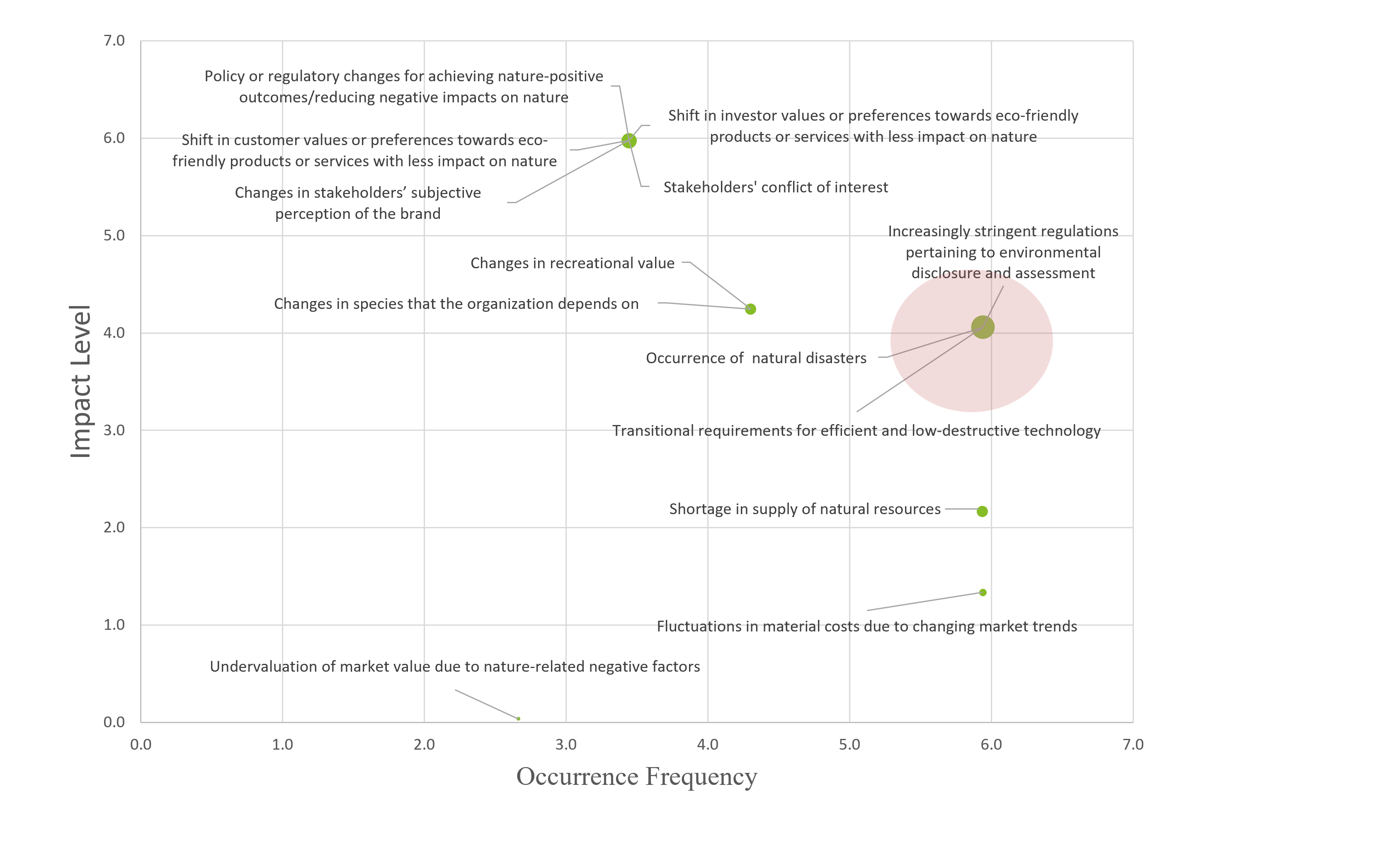
CHT Nature-Related Risk Matrix
Note : The size of the green dots in the matrix diagram represents the quantified results of the working group and indicates the order of priority. This analysis first uses the red area for planning natural risk response strategies.
- Identifying Natural Opportunities
Significant natural opportunity factor items identified by Chunghwa Telecom.
| Value Chain Scope | Natural Opportunity Factors |
|---|---|
| Chunghwa Telecom's Own Operations |
|
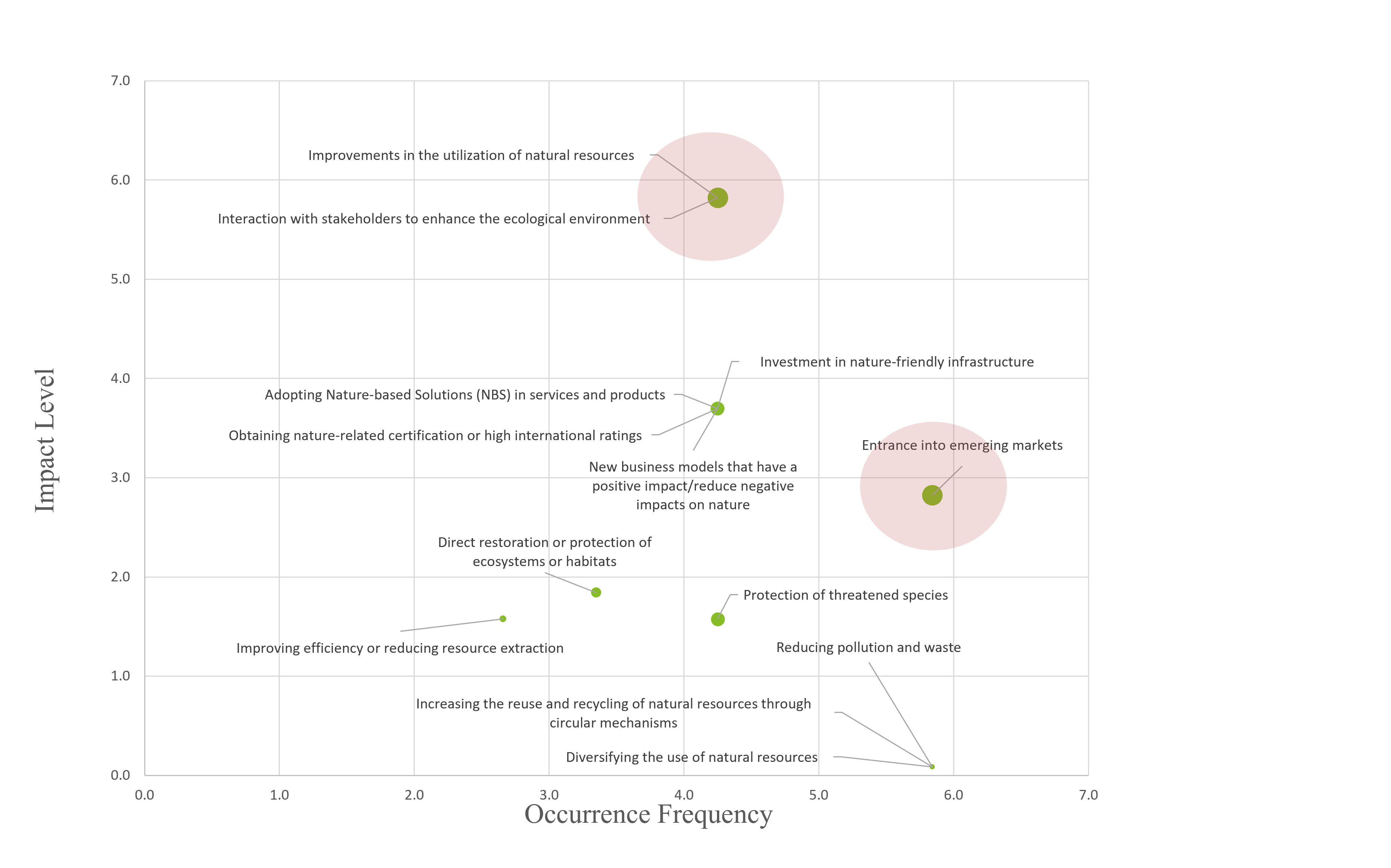
CHT Nature-Related Opportunity Matrix
Note : The size of the green dots in the matrix diagram represents the quantified results of the working group and indicates the order of priority. This analysis first uses the red area for planning natural opportunity response strategies.
➤ Prepare:Strategies and Goals for Nature Conservation
After identifying the natural risks and opportunities for Chunghwa Telecom, the TaskForce Team collaborates with various business units to assess how dependencies, risks, and opportunities related to nature impact the company's business model. Following this assessment, corresponding response strategies are developed, and indicators and goals are established to evaluate and manage interactions with nature.
Nature-Related Risks and Impact Management
Chunghwa Telecom faces challenges such as market competition, technological changes, regulations, and climate change. To ensure robust development and sustainable operations, the "Risk Management Committee" was officially established in 2016 and upgraded in 2023 to a functional committee under the board of directors. It serves as the highest decision-making and supervisory body for risk management, with the chairman and over 50% of its members being independent directors.
Chunghwa Telecom's board of directors formulates risk management policies and establishes the "Risk Management Committee" to supervise these policies and procedures. At the operational level, a "Risk Management Promotion Committee" is set up to specifically execute overall risk control operations. The Audit Department reviews risk events, reporting already occurred risks to the Audit Committee, while imminent or preventative risks are reported to the Risk Management Committee.
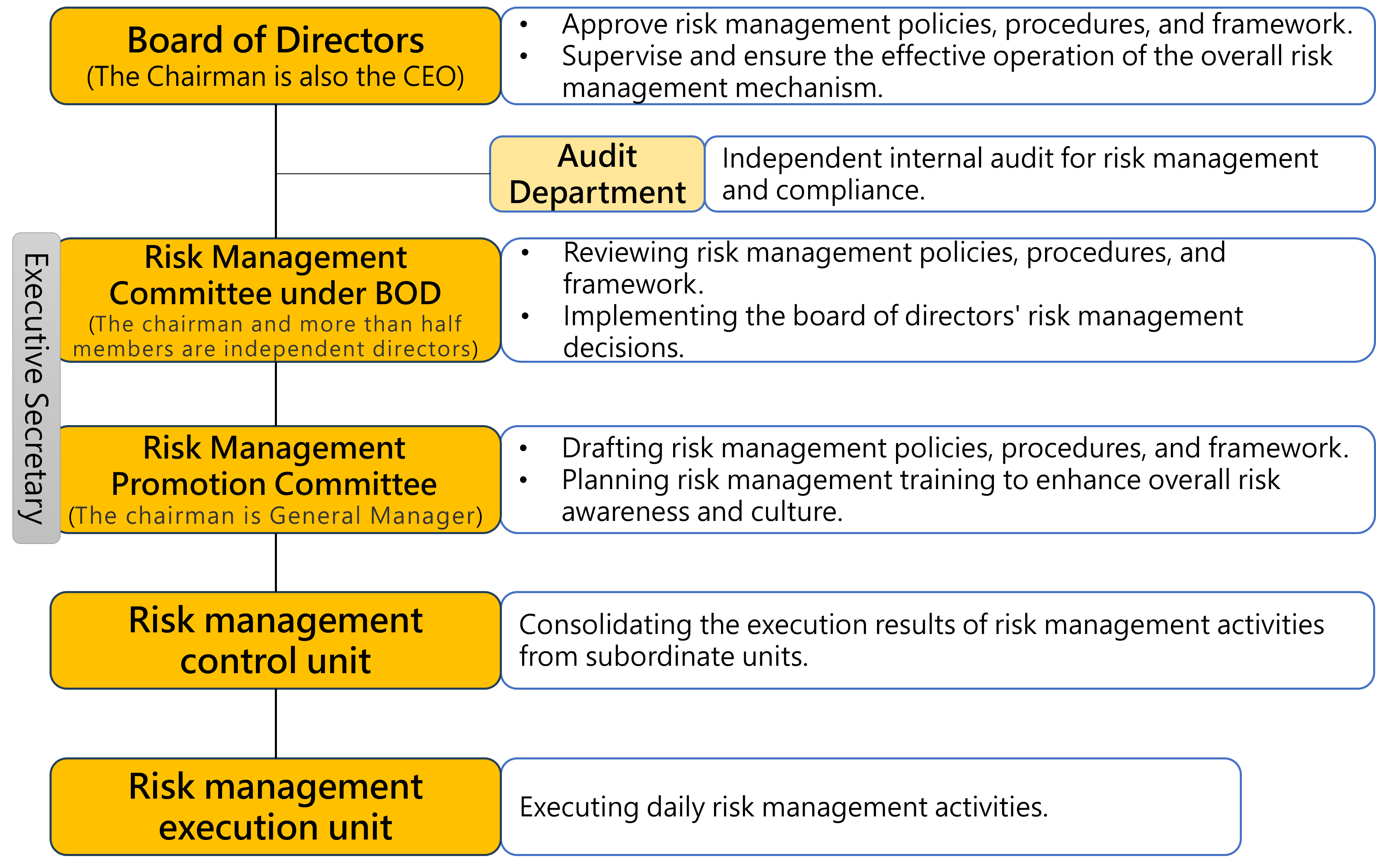
CHT Risk Management Organization Structure
To ensure uninterrupted operations and protect stakeholder interests, Chunghwa Telecom analyzes operational objectives, ensures financial reporting accuracy, and manages high-impact risk events to identify and control operational risks. Currently, Chunghwa Telecom manages risks through the Enterprise Risk Management (ERM) system and plans to incorporate emerging risks, such as nature-related issues, into its risk management. Relevant departments collaborate with upstream and downstream partners in the value chain to propose preventive or mitigating strategies to reduce environmental impact, enhance biodiversity, and build a resilient value chain.
Notes:
1. The Taskforce on Nature-related Financial Disclosures (TNFD) is a global organization dedicated to enhancing corporate disclosure of nature-related risks and opportunities. Its members come from various sectors, including biology, financial institutions, corporations, government agencies, and more, encompassing 74 entities worldwide. The taskforce collaboratively develops frameworks to help businesses assess nature-related risks and opportunities and report more comprehensively on their interactions with nature.
2. The LEAP methodology of the TNFD is a framework designed to help companies systematically identify, evaluate, and manage nature-related risks and opportunities. LEAP is an acronym for four steps: Locate, Evaluate, Assess (risks and opportunities), and Prepare (to take action).
3. Regarding localized Locate and Evaluate analysis process, please refer to the 2023 edition of the Chunghwa Telecom TNFD report for more details.
4. Considering the interdependence and impact between Chunghwa Telecom's operations and nature, the scope of the biodiversity assessment has included the areas surrounding the company's various sites. Please refer to the "Biodiversity Risk Analysis Methodology" for detailed explanations.
5. The taskforce is a collaboration between Chunghwa Telecom, National Taiwan University, the International Climate Development Institute (ICDI), and The Sustainable Transformation Service Team from Deloitte & Touche Risk Management Advisory Co., Ltd.
6. ENCORE is to help financial institutions and businesses understand the dependencies and impacts of their activities on natural capital. ENCORE provides a database that illustrates how various economic activities rely on different types of natural capital (such as water resources, soil quality, air quality, etc.) and how these natural capital elements influence business risks.
7. The entire region including Taiwan, Penghu, Kinmen, and Matsu areas.
8. Biodiversity-related environmentally sensitive areas include nature reserves, nature conservation areas, wildlife protection areas, key wildlife habitats, reservoir catchment areas, water quality protection zones, Taiwan Coastal Area Nature Environment Protection Plan (I), Taiwan Coastal Area Nature Environment Protection Plan (II), internationally important wetlands, nationally important wetlands, national forest enterprise zones, national parks, national nature parks, reservoir watersheds, second-class coastal protection zones, aquatic animal and plant breeding conservation zones, artificial reef zones, and protected reef zones.
9. The operational impact items of the location are directly composed of the influencing driving factors.
Documents
-
 Chunghwa Telecom Co., Ltd. 2023 TNFD Report
Chunghwa Telecom Co., Ltd. 2023 TNFD Report



